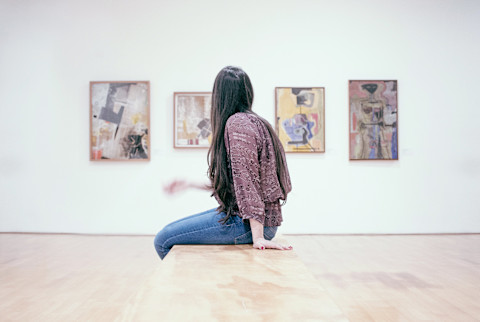How Setting Aside Weekly "Art Time" Can Reduce Stress & Anxiety

In the rugged peaks of Tibet, a 7-year-old and a 12-year-old are making their mark, pressing tiny hands and bare feet onto soft limestone, their giggles echoing through the mountains. Unbeknownst to them, their playful mosaic will survive 200,000 years, their innocent act bearing a deeper, symbolic message about the meaning of their existence.
This mosaic, described in a study recently published by David D. Zhang and his team1, is a testament to the primal nature of art. Other studies have also revealed forms of prehistoric art from Indonesia and Europe dating back 40,000 years2. Together, these discoveries remind us that creativity and the creation and appreciation of beauty are ancient human instincts to bridge our nervous systems beyond ourselves.
They can help connect our deepest nature with the world around us, and even beyond that, to the great mysteries of life, the universe, and existence itself.
The science of neuroaesthetics
The impact of art on the nervous system is the subject of considerable recent research in neuroaesthetics3, a new field of scientific research that combines neuroscience, art history, and psychology to understand the relationship between art and our brains.
Many activities of creating or appreciating beauty have been scientifically demonstrated to have positive benefits to the nervous system. Drawing or coloring, for instance, is a simple activity that can help dial down anxiety levels4. Studies show that these activities can calm minds and even slow heart rates5. It's not just for kids either. One study showed that mandala coloring helped reduce anxiety in older adults6. Here are a few ways to reap the benefits of neuroaesthetics:
- Mindfulness-based art therapy, which combines meditation practices with tactile art experiences, has measurable benefits. It can improve sleep, reduce symptoms of anxiety and stress, and even lower blood pressure.
- Engaging in poetry, whether by reading or writing it, fires up unique parts of our brain. The rhythm and sound patterns in poetry stimulate different areas of the brain than regular speech or writing does.
- Visual art, such as drawing, painting, or sculpting clay, has a real and positive impact on the brain. Any form of visual creative expression, including activities as varied as cake decorating and scrapbooking, can activate the brain's reward pathway. One study even showed that creating art for 45 minutes could significantly lower stress hormone levels7, and this was true for both experienced and novice artists.
- Then there's dance, an art form that involves the whole body. Research shows that dancers are more sensitive to emotions8 expressed through body movements. So whether you're a professional ballet dancer or just cutting a rug in your living room, dance can help you connect with your emotions and those of others. Even the sound frequency of music can affect us, with research showing that music at 528 Hz can reduce stress and anxiety.
Do this: Express yourself
Expressing yourself artistically can be a powerful way to cultivate a sense of connection and further increase your nervous system regulation. Here are some suggestions to help you engage with beauty and creative self-expression:
Explore various art forms
There's no hierarchy in art. All forms, be it painting, sketching, dancing, writing, or music, have their unique charms and benefits. The key is to explore and experiment. For example, today you might resonate more with watercolor painting, capturing the vibrant colors of a sunset. Tomorrow, you might feel drawn to expressing yourself through poetry or immersing yourself in the rhythm of dance. The beauty of art is in its diversity, so don't restrict yourself.
Engage your senses
Art is a multisensory experience. When painting, feel the brush strokes on the canvas, notice the blend of colors, smell the paint, and listen to the ambient sounds around you. If you're dancing, pay attention to the feel of the floor beneath your feet, the rhythm of the music, and the way your body moves. By using all your senses, you deepen your connection to the activity and the world around you.
Don't worry if you're not an expert or a professional artist
You don't need to be! Art is a personal journey and it's the process of creation that matters, not just the results. So whether you're doodling on a notepad, strumming an unplugged guitar, or molding clay with your hands, remember it's about expression, not perfection.
Make art a habit
Consistency can enhance the benefits of art. Consider setting aside specific "art time" each week. This could be anything from an hour of drawing every Saturday morning to a five-minute daily doodling break.
Switch to lion mind
Try to be present in the moment while creating. If you're writing a story, immerse yourself in the narrative. If you're dancing, let the movement and music guide you.
Express emotions through art
Art can be an effective outlet for expressing emotions. For instance, if you're feeling stressed, you might want to create an intense, abstract painting with bold colors. If you're feeling calm and peaceful, you might prefer sketching a serene landscape.
The takeaway
Creative expression is a fundamental aspect of being human. By connecting with your innate creative instincts to make art, express yourself, or appreciate beauty, you open up your nervous system to deeper levels of connection between your most intimate self and the vibrant world around you, improving your overall regulation, flexibility, and resilience for the long term.
Adapted from an excerpt of Heal Your Nervous System: The 5-Stage Plan to Reverse Nervous System Dysregulation by Linnea Passaler, DMD, with permission from the publisher.
8 Sources
- https://www.sciencedirect.com/science/article/pii/S2095927321006174
- https://www.nature.com/articles/nature.2014.16100
- https://www.sciencedirect.com/topics/psychology/neuroaesthetics
- https://pubmed.ncbi.nlm.nih.gov/36895711/
- https://www.ncbi.nlm.nih.gov/pmc/articles/PMC6015920/
- https://www.tandfonline.com/doi/full/10.1080/07421656.2021.2003144
- https://www.tandfonline.com/doi/abs/10.1080/17533015.2016.1217248?needAccess=true
- https://psycnet.apa.org/doiLanding?doi=10.1037%2Fxhp0000176
